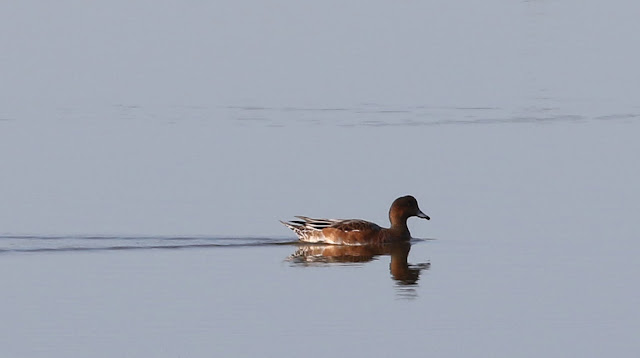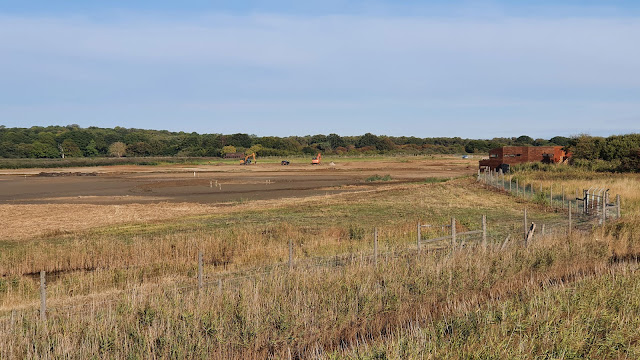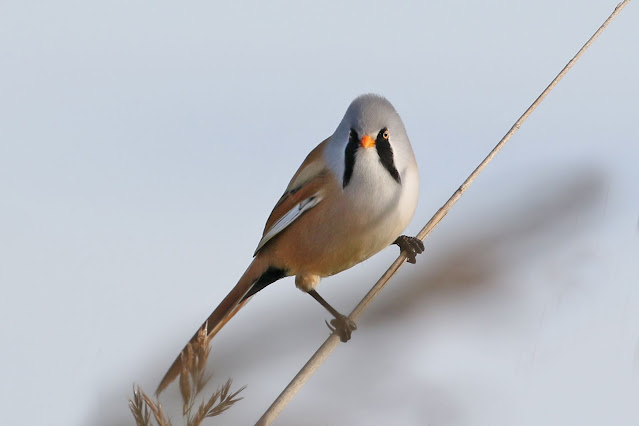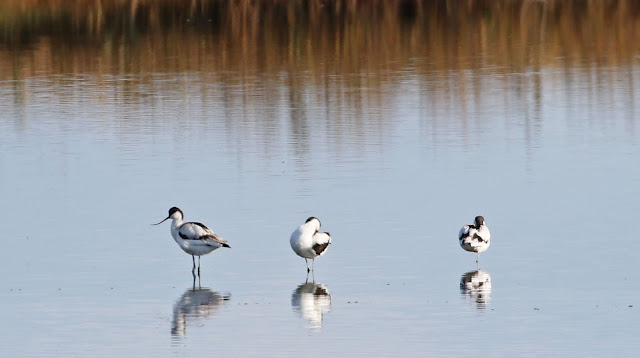As the week drew to an end I had the chance to visit Minsmere once more. It was a lovely morning, sunny and with very little wind. I had been debating what to do when I arrived, should I go straight to the Bittern hide or walk the dunes. While I had a feeling there would not be much around the bushes I just had to go along the North Wall to the beach, something always draws me to the beach.
Walking along the North Wall, this morning I could hear the pings of Bearded Tits, the still conditions making it easier for them and me. I walked up to the path through the dunes and headed towards the Sizewell monolith.
I mentioned earlier that there was a reason for not visiting the east hide, well this it the scrape viewed from the public hide looking across to the south hide, tidy island and plenty of water, the only thing missing are the birds.
All this means that there are no birds on this part of the scrape, despite this there were people, without binoculars looking out of the windows!
As I reached the Sluice I could hear the familiar calls of a group of Bearded Tits, having failed to get good views of them on my last visit I was determined to get some better views today. I dropped down into the reserve and stood and waited. I could hear them from the reeds alongside the East River, from the "pings" this was a large group and eventually they showed at the top of the reeds.
Female types to start with
The Bearded Tit, or more appropriately named – Reedling, is
not a tit at all but belongs to a family of East-Asian birds called
parrotbills. Bearded Tits are in fact more closely related to thrushes
than tits.
Bearded tits are the only British songbird to stay in
reedbeds all year round. Originally they were limited by the availability of
reedbeds in Britain, but thanks to newly created or expanded reedbeds, they are
now more widespread and can be found in parts of eastern and southern England,
Morecambe Bay in northwest England and around the Tay estuary in Scotland.
Although bearded tits are not well known for migration,
there is some movement in the autumn through local dispersal. On occasion,
there is also an influx of continental birds from mainland Europe. They are
more gregarious outside of the breeding season, and therefore tend to be easier
to see.
Turning the corner there were Wigeon on the pools alongside the path.
But once again it was the calls of Bearded Tits that stopped me and I was faced with a huge flock of around 50 birds in the reeds on both sides of the path.
Bearded tits survive in the reedbeds all year round by
changing their diet from insects during the spring and summer, to seeds in the
autumn and winter. They cope with this by altering their gut morphology, and by
eating large amounts of grit particles that help to grind down the tough seed
fibres. This is what was attracting the birds to the area next to the path, they were collecting grit
One male became very showy at the top of a reed stem allowing me some wonderful views once again.
Due to their range restriction, bearded tit populations can
be vulnerable to particularly harsh winters, flooding and saltwater inundation
into reedbeds. As a result local extinctions can occur. For example, in the
cold winter of 1947 the East Anglian population decreased to just four or five
pairs in Suffolk and a lone male in Norfolk. It is thought that the snow cover
prevented them from accessing the seeds they needed to survive. Lets hope this winter doesn't turn out to be that bad.
Then like before the flock was gone in a chorus of "pings" and associated calls. I walked on completely satisfied with my decision to head out to the beach. But now I was off to the Bittern hide to stare at reeds.
I stopped alongside the south hide to watch three Avocet in the still water. I had to have a photograph of an Avocet at RSPB Minsmere.
Here you can appreciate the long legs that are used to snatch prey.
I didn't have the time I had on Saturday to sit out the Bittern Hide so moved on to the Island Mere. On the way I came across what looked like a family party of Wren
I parked close to the house and found a map of the reserve. The report I had seen said it was viewable from a platform off the old railway line on the South Marsh. I knew where this was and set off across the reserve, finding a Green Woodpecker and Kestrel along the way. When I reached the platform it looked out over a marsh but no water! I scanned the marsh and could see on the other side a platform with birders. This was clser to where I had parked the car!
I set off back, walking and running around the path I had just walked and arrived at the platform to this scene.
Later on we were treated to yet another spectacular sunset over the River Alde estuary.





















































